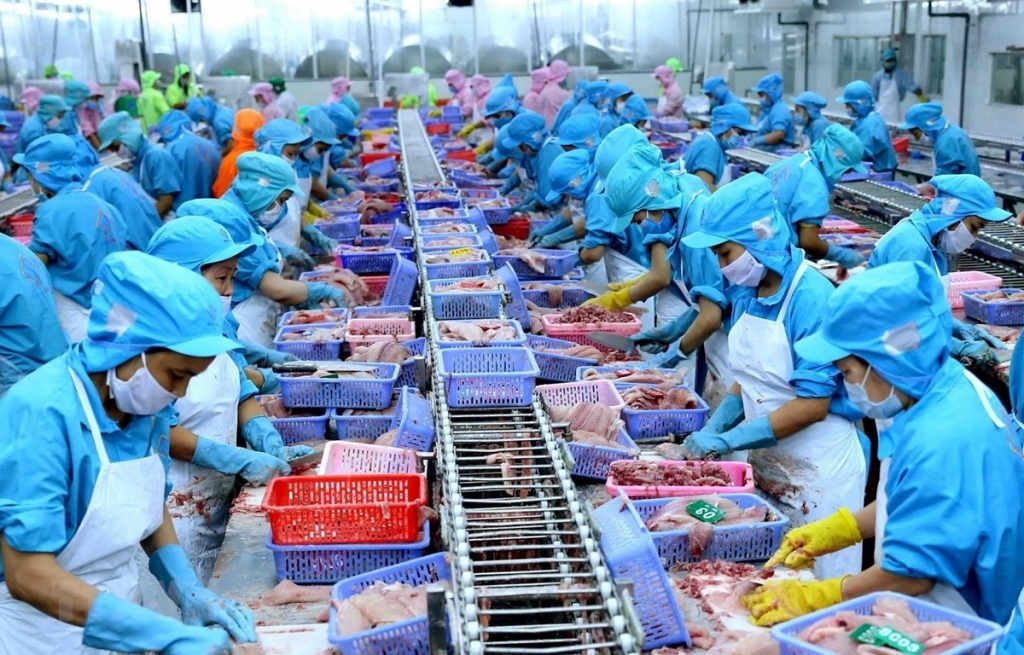 |
Enterprises exporting to the Canadian market is facing competitive pressure on prices. |
The exchange rate policy is detrimental when Vietnamese goods are exported
According to the Vietnam Trade Counselor in Canada, Canada’s import trend continues to record stable growth compared to the same period in 2022, reaching 9.4%, with a total import turnover of US $ 85.8 billion. In addition, most of the areas of Canadian imports in which Vietnam has strengths maintain positive growth rates over the same period in 2022, such as clothing, electronics, electrical appliances, optical equipment, and photography.
However, Canada saw a decrease in import demand in some sectors: plastics (-8.7%), precious metals (-13.5%), furniture (-0.3%), steel (-16.7%) and chemicals (-10.3%), seeds and nuts (-1.6%), aluminium (-3.1%). As a result, Canada’s reduction in import demand immediately negatively impacted Vietnam’s exports in these areas (except furniture).
According to the analysis of Ms Tran Thu Quynh, representative of the Vietnam Trade Counselor in Canada, from a local perspective, the biggest factor hindering Vietnam’s exports is domestic transport and logistics capacity, and the lack of Labor makes Vietnam’s export prices less competitive than its South American neighbours.
On the other hand, the fact that Canada maintains a low exchange rate policy to promote exports is also detrimental to Vietnam’s exports because the price of Vietnam will become more expensive in 2022 if measured in local currency.
Notably, some important areas of Vietnam’s export products to the region are also at risk of being subject to anti-dumping duties or considering an extension of anti-dumping duties, such as solar panels (currently at present). Vietnam accounts for nearly one-third of Canada’s market share); Corrosion-resistant steel, copper pipe fittings, and upholstered seats are significant obstacles to Vietnam’s export potential to the Canadian market.
In addition, the fact that Canada has more bilateral FTAs and promotes policies towards the South American economic bloc and allied economies, prioritizes trade with democracies, promotes less developed emissions trade and reducescarbon consumption footprint are also trends that have a long-term impact on Vietnam’s ability to grow exports sustainably.
Competition pressure
According to the Vietnam Trade Counselor in Canada, for some specific product areas, the decline in exports not only in 2023 but also in the next few years is an inevitable trend.
For example, the seafood this sector has a sharp decline in 2023 due to a lack of price competition compared to similar products inChina, India, Chile, and Ecuador. In addition, Canada’s push to sign a series of bilateral and regional FTAs will make it harder for Vietnam to compete with its South American neighbours.
For iron and steel, currently, the construction sector is very negatively affected because the loan prices of banks are too high and inflation, especially in the field of essential goods, is high, making the demand for shopping and home repair very high. As a result, the door fell sharply; public infrastructure investment has been implemented quite slowly due to the industry’s labour force shortage.
In particular, rice, vegetables and fruits are the areas in which Vietnam finds it difficult to keep a competitive position with rivals such as the United States and South America due to geographical advantages and transportation costs. Furthermore, many South American countries have begun to invest heavily in the development of similar tropical fruit trees to Vietnam: jackfruit, mango, lychee, rambutan, custard apple, dragon fruit, and mangosteen, and promote exports to Canada in recent months.
For the textile and garment sector, the representative of the Vietnam Trade Office in Canada also informed about the new enhanced Universal Preferential Tariff Program launched by this country. This is a new tax incentive program created by Canada in this year’s budget plan to provide incentives to countries that, according to Canada, meet standards on human rights, gender equality, working conditions and Climate Change. At the same time,the Common Tariff Program will not impose additional social and environmental criteria.
This is a big disadvantage for Vietnam’s textile and garment industry when major textile and garment competitors such as Bangladesh, Cambodia, Haiti, Sri Lanka, Pakistan, Kenya, Egypt and El Salvador.
According to the Vietnam Trade Office in Canada, these are the main difficult factors that negatively affect the export potential to this market, thereby identifying and taking appropriate solutions.
